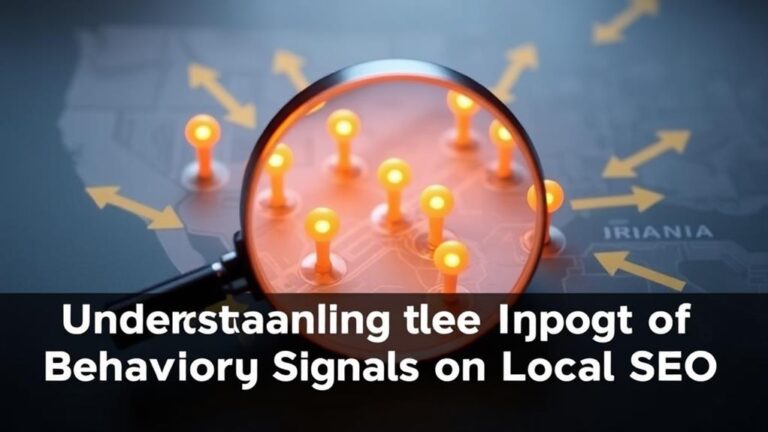Local SEO is essential for service area businesses, like plumbers or locksmiths, to improve online visibility and attract local clients. Start by optimizing your Google Business Profile; choose accurate categories and maintain consistent Name, Address, and Phone number details. Highlight the importance of customer reviews, which enhance credibility and rankings. Create dedicated service area pages with quality content and targeted keywords to boost engagement. Utilize Local Services Ads for prominent visibility. Remember, ongoing updates and active customer interaction can greatly improve your reputation and search performance. Discovering more strategies will further enhance your local SEO success.
Understanding Service-Area Businesses
When you think about Service Area Businesses (SABs), picture companies that deliver services right to your door without a storefront. Unlike traditional retailers, SABs include locksmiths, HVAC providers, cleaning services, and plumbing companies, all operating across various areas.
These businesses must leverage effective local SEO strategies to enhance visibility in their target markets. Since these businesses don't have a physical location for customers to visit, they must focus on building a robust online presence.
To succeed in local SEO for SABs, you need to guarantee NAP consistency—making sure your Name, Address, and Phone number are the same across all online platforms. This consistency helps boost your local visibility and improves your search rankings.
It's crucial to conceal your physical address in online listings to protect your privacy while adhering to Google Business Profile guidelines.
Using Google Business Profile, you can define up to 20 service areas, including cities, zip codes, and counties, enabling you to target your audience more effectively.
By optimizing your profile and guaranteeing that your NAP information is consistent, you enhance your chances of being discovered by potential customers actively seeking your services.
Understanding SABs is the first step toward making your business stand out in a competitive market.
Setting Up Google Business Profile
When setting up your Google Business Profile, choosing the right business category is crucial, as it directly affects your visibility in local searches.
An optimized profile with accurate business information, such as descriptions and relevant attributes, can greatly enhance customer trust and search performance.
You can define your service area without providing a physical address, which helps you reach customers across multiple locations.
To make the most of your profile, focus on optimization techniques like regularly updating information and using Google Q&A to connect with potential clients, as effective GMB management strategies can drive engagement and visibility.
Business Category Selection
Choosing the right primary business category in your Google Business Profile (GBP) is fundamental for service area businesses looking to enhance their local search visibility. This selection directly influences your local search ranking, helping potential customers find you more easily.
When you set up your GBP, pick a primary business category that accurately reflects your main services, as this contributes to maintaining NAP consistency, which is essential for local SEO. This decision not only showcases what you offer but also positions you favorably in local SEO.
In addition to the primary category, you can choose additional categories to capture a broader audience and represent your services more thoroughly.
Regularly reviewing and updating your business category is significant, especially if your services evolve or market focus shifts. Keeping your categories current guarantees you remain competitive in local searches.
Service Area Definition
Defining your service area accurately is essential for optimizing your Google Business Profile (GBP) as a Service Area Business (SAB). Start by opting out of providing a physical address to maintain an address-free listing. Instead, you can define up to 20 service areas using cities, ZIP codes, or counties. This service area definition plays an important role in enhancing your local search visibility.
Choosing the right primary business category is just as important, as it greatly impacts your ranking in local searches. You can always add additional categories later to broaden your reach. By accurately defining your service areas, you increase your chances of appearing in local search results, even for clients located outside your immediate vicinity.
Don't forget to create service area pages that highlight specific services you offer, incorporating relevant local keywords. Regularly updating your GBP with engaging content, like images and service descriptions, will keep your profile active and attractive to potential customers.
Profile Optimization Techniques
Setting up your Google Business Profile (GBP) is vital for enhancing your online presence as a service area business. Start by visiting google.com/business to verify any existing profiles, ensuring you avoid duplicates. This step is important for effective local SEO.
Next, choose a primary business category that accurately reflects your services. You can add up to 20 specific service areas using cities, zip codes, and counties, allowing you to target your audience without needing a physical address.
To optimize your profile further, include detailed service descriptions and high-quality images that showcase your work. This visual appeal can greatly enhance customer engagement.
Don't forget to utilize the Q&A feature on your GBP; providing helpful information without promotional language can build customer trust and credibility.
Regularly updating your GBP with fresh information, offers, and images keeps your profile relevant and engaging. This practice not only attracts potential customers but also positively impacts your local search rankings.
Optimizing Your GBP Listing
When it comes to optimizing your Google Business Profile (GBP) listing, selecting the right primary business category is vital for enhancing your local search visibility. This choice greatly influences your local search ranking, so make sure it accurately reflects your services.
In addition, utilize the option to define your service area by entering up to 20 locations, including specific cities and zip codes, to reach potential customers more effectively.
Regularly updating your GBP with high-quality images can boost your engagement. Listings with images receive 42% more requests for directions and 35% more clicks to your website, making visuals a powerful tool for your local business.
Engage customers by actively using the Google Q&A feature to address common inquiries. This builds trust and credibility without sounding promotional.
Moreover, monitoring and responding to customer reviews promptly is essential. Fresh reviews not only elevate your GBP ranking but also enhance your business's reputation, attracting more customers.
Ranking Challenges for Service-Area Businesses
Service-area businesses (SABs) encounter distinct ranking challenges in local SEO, primarily due to their absence of a physical storefront. This lack of a fixed location makes it difficult for search engines to assess proximity to potential customers. Instead, prominence and relevance become essential local search ranking factors for SABs, which often rely on their online presence to attract clients.
One notable challenge is competing against traditional businesses that can easily target localized keywords based on specific locations. This strategy often leaves SABs struggling to rank for broader service area searches.
Additionally, how you define and manage your address within your Google Business Profile can greatly impact your visibility. Making sure your service area is clearly defined helps search engines understand where you operate.
Customer reviews also play a vital role in overcoming these ranking challenges. Positive feedback can enhance your credibility and visibility in competitive local searches. Thus, actively encouraging satisfied customers to leave reviews can make a difference.
Importance of Customer Reviews
In today's digital landscape, customer reviews are important for local SEO success. If you want your service area business to thrive, you need to understand that positive customer reviews greatly boost your visibility on Google Maps.
Businesses with higher ratings and more reviews are more likely to show up in Google's Local Pack, which directly affects your search visibility.
Moreover, fresh reviews play an important role in improving your rankings. Google prioritizes updated content, so regularly soliciting and responding to reviews is crucial.
When you engage with both positive and negative feedback, you demonstrate to potential customers that you value their opinions and are committed to satisfaction—this enhances your reputation management.
It's also important to encourage reviews from customers in your targeted service areas. Doing so can strategically enhance your search visibility and rankings for those specific locations, as Google considers the relevance of reviews in local searches.
Building a 5-Star Reputation
To build a 5-star reputation, you need to systematically collect reviews from your customers.
Engaging with both positive and negative feedback shows you care about their experience, which can boost your credibility and search visibility.
Systematic Review Collection
Building a stellar online reputation hinges on systematically collecting customer reviews. A solid collection strategy can greatly enhance your service area business's visibility and credibility. Since 72% of consumers only take action after reading positive reviews, it's essential to prioritize this process.
Your Google Business Profile plays an important role here, as fresh reviews not only improve your local SEO but also signal to Google that your business is active and trustworthy.
To streamline your systematic review collection, consider using tools like Reputation Manager. These tools help you efficiently monitor and respond to feedback across various platforms, ensuring no customer voice goes unheard.
Regularly encouraging customers to leave reviews will keep your profile updated and appealing to potential clients.
Engaging With Responses
Engaging with customer reviews right after they're posted can set your service area business apart from the competition. By promptly responding to reviews, whether they're positive or negative, you demonstrate responsiveness, which can greatly enhance your online reputation.
Research shows that businesses that actively engage with customer reviews see a 16% higher likelihood of attracting new customers.
When you take the time to respond to reviews, you not only build trust but also improve your business visibility in local search results. In fact, businesses that manage their online reputation effectively can boost their visibility by up to 70%. This means that regularly engaging with customer reviews can directly impact your local search ranking.
Additionally, encouraging satisfied customers to leave reviews across multiple platforms can enhance your brand presence and even lead to a 10% increase in conversion rates.
By consistently engaging with customer reviews, you cultivate a 5-star reputation that attracts more clients and establishes your business as a trusted choice in your service area.
Using Local Services Ads
Local Services Ads (LSAs) are a powerful tool for service-area businesses looking to enhance their online presence. By appearing at the top of Google search results, LSAs offer you prominent visibility, allowing you to showcase your reputation and services directly to potential customers.
With LSAs, you can set a monthly budget and only pay for leads generated, making this a cost-effective option for local service marketing.
These ads highlight essential business information, including customer reviews and ratings, which can greatly influence consumer trust and decision-making. When consumers see positive feedback about your services, they're more likely to reach out.
Additionally, LSAs let you select specific service categories and geographic areas, ensuring your ads target the most relevant audience within your service area.
Comprehensive studies indicate that consumers are more likely to contact businesses displayed in Local Services Ads compared to traditional search results. This enhanced visibility not only boosts lead generation for service-area businesses like yours but also helps you build a solid reputation in your community.
Creating Service Area Pages
Service Area Pages (SAPs) play an essential role in enhancing your online visibility by targeting specific geographic locations. By creating these pages, you can effectively reach potential customers in your service areas, driving more relevant traffic to your site.
Here are three key steps to take into account when creating effective service area pages:
- Develop Unique Content: Each SAP should feature high-quality, unique content tailored to that specific location. This helps you avoid penalties from search engines for duplicate content and keeps your audience engaged.
- Conduct Targeted Keyword Research: Focus on localized keywords that resonate with your target audience. Search engines prioritize relevant local content, so verify your SAPs reflect the language and needs of your customers.
- Link to Your Google Business Profile: Integrate your SAPs with your Google Business Profile. This connection not only boosts your local SEO but also helps you define your service areas more effectively.
Don't forget to update your SAPs regularly with fresh content and customer testimonials. This approach can greatly enhance engagement and improve your search rankings over time, solidifying your online presence in local markets.
Advanced Local SEO Strategies
When it comes to advanced local SEO strategies, targeted keyword research is your first step to understanding what your customers are searching for.
By effectively optimizing your service area pages and local listings, you can boost your visibility and attract more clients from specific neighborhoods.
Let's explore how these tactics work together to enhance your online presence and drive more local traffic to your business.
Targeted Keyword Research
Effective targeted keyword research is essential for any Service Area Business (SAB) aiming to dominate local search results. By identifying local keywords that reflect the services you offer and the areas you serve, you can greatly enhance your online visibility.
Here are three key steps to guide your research:
- Use Tools: Leverage tools like SEMrush or Google Keyword Planner to uncover high-value search terms and long-tail keywords that potential customers might use, such as "emergency plumbing services in [City Name]."
- Analyze Competitors: Look into your competitors' keyword strategies to discover effective local keywords they're using. This can highlight gaps you can exploit, giving you an edge in local rankings.
- Optimize Regularly: Keep your website and Google Business Profile (GBP) updated with newly researched keywords. This helps you stay relevant and adapt to changing search behaviors in your service areas.
Incorporating local keywords into meta titles, headings, and content can further enhance your SEO performance, ensuring you align well with user search intent.
Targeted keyword research is your roadmap to attracting qualified leads and boosting your local presence.
Service Area Pages
Creating dedicated Service Area Pages (SAPs) can greatly enhance your local SEO strategy. These pages are critical because they can rank higher than your homepage for specific local service searches, driving targeted traffic to your site.
To maximize their impact, each SAP should feature unique, optimized content tailored to specific cities or neighborhoods. Incorporate relevant keywords and long-tail phrases that improve your visibility in local search results.
Effective SAPs include clear service descriptions, FAQs, and engaging visuals like images and videos. This extensive information not only enhances user engagement but also boosts your conversion potential.
Regularly updating and monitoring your SAP performance metrics is essential, as it allows you to identify underperforming pages and adapt your strategies accordingly.
Additionally, implementing structured data markup on your SAPs can further enhance your search engine visibility. This markup helps Google better understand your content, which can improve your rankings in local search results.
Local Listings Optimization
Optimization is key to achieving visibility in local search results, especially for Service Area Businesses (SABs). To effectively enhance your local listings optimization, focus on these strategies:
- Maintain Consistent NAP: Confirm your Name, Address, and Phone number are the same across all platforms. This consistency builds trust with search engines and improves your ranking.
- Utilize Google My Business: Claim and optimize your Google My Business listing. Include local keywords in your business description and service offerings to increase relevance in targeted areas.
- Implement Citation Management: Use citation management tools to automate the process of maintaining accurate listings across various directories. This helps you save time and confirms your information stays current.
Additionally, regularly update your listings with fresh content like new services, promotions, or customer reviews.
Engaging with customers through Q&A sections also enhances visibility, as Google rewards businesses that actively respond to inquiries.
Continuous Learning Resources
To stay ahead in local SEO for service area businesses, you'll want to tap into a variety of continuous learning resources. Engaging with local SEO experts through webinars and workshops can provide valuable insights into the latest strategies and trends. These sessions often focus on SEO best practices tailored specifically for service area businesses, helping you refine your approach.
Utilizing online resources like blogs, articles, and guides from reputable sources such as Moz and Search Engine Journal can greatly enhance your understanding of local SEO. Participating in community forums and platforms like Reddit or local SEO groups on Facebook fosters knowledge exchange, offering peer feedback on SEO challenges and solutions.
Regularly checking updates from Google's official Search Central Blog guarantees you're informed about algorithm changes and their impact on local search visibility.
Additionally, implementing tools like SEMrush or Ahrefs can provide analytics insights, highlighting areas for improvement in your local SEO efforts. By consistently exploring these resources, you'll strengthen your digital marketing skills, stay current in the industry, and improve your business's online presence.
Conclusion
In the dynamic world of local SEO, mastering strategies for service-area businesses can feel like maneuvering through a labyrinth. Yet, with the right tools and techniques—from optimizing your Google Business Profile to harnessing customer reviews—you can light your path to success. Embrace continuous learning and stay ahead of the competition. By implementing these strategies, you'll not only enhance your online presence but also build lasting connections within your community, turning potential customers into loyal advocates.




